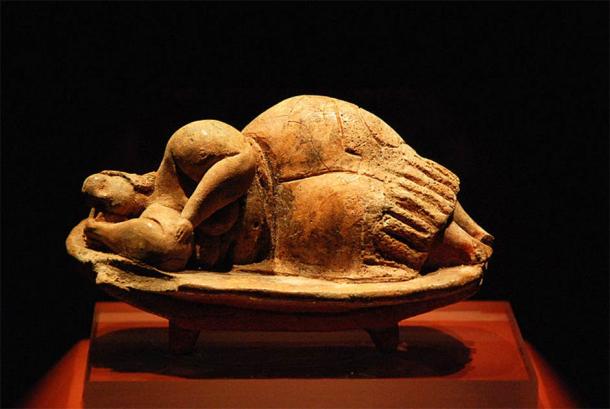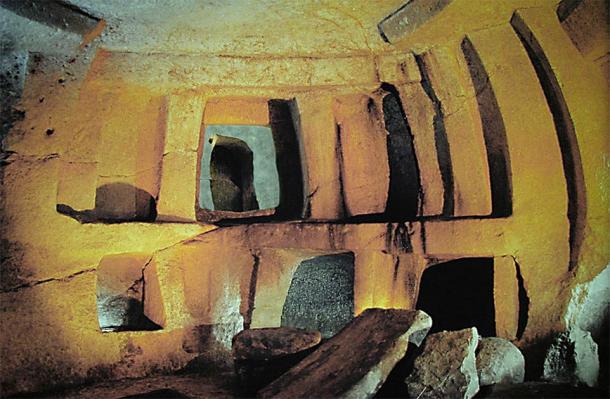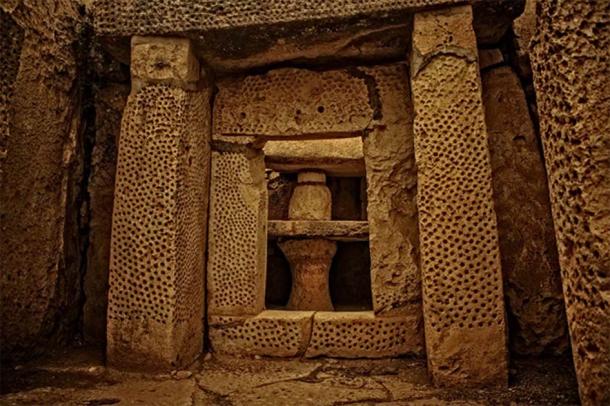Despite claims by experts and historians, not all of human history can be easily explained and many mysteries still remain. Just south of Sicily, surrounded by sapphire waters and sun-soaked shores, the islands of Malta hold many secrets. Prehistoric Malta, along with her sister island Gozo, is filled with archaeological sites including dwellings, temples, and vast subterranean sanctuaries.
Within the few sites of Malta that have been excavated, many strange objects have been found ranging from votive offerings and bones of bygone animal species, to dismembered and burnt human remains, trepanned elongated skulls, stone spheres, enigmatic channels and modified teeth. Archaeologists have even discovered iconic sculptures of an obese woman, culturally linked to carvings found in caves from Spain to Siberia, dating back as far as forty thousand years.
Stranger still, once the primary hypogeum was excavated it was discovered to have unique acoustic properties which appear to have been deliberately designed. Since it’s accidental discovery in 1902, the Hal Saflieni Hypogeum has become a cauldron of speculation, myth, and scientific misconduct. Meanwhile several other sites, such as the Xaghra Hypogeum, are being suppressed entirely.

The Sleeping Lady was discovered in the Hal Saflieni Hypogeum and has since become an icon of prehistoric Malta. (Jvdc / CC BY-SA 3.0 )
Hal Saflieni Hypogeum and Xaghra Hypogeum: Catastrophe and Misconduct on Malta
It’s quite difficult to summarize the chronology of discoveries, excavations, and reconcilement of archaeological sites on Malta due to the fact that this constitutes an utter coprolite storm of catastrophes and misconduct. We can however begin in 1903 when the Maltese Jesuit archaeologist, ethnographer, and writer Manuel Magri excavated the accidentally discovered hypogeum.
It must be stressed that Magri is one of few early researchers who are excluded from charges of misconduct. Magri devoted his life to preserving knowledge and traditions from the distant past. He is now falsely accused of discarding artifacts from the hypogeum, but the reality is, that only five short years after excavating the hypogeum, Magri died “unexpectedly” and all his reports on the excavation were suspiciously “lost.” According to a May 1920 edition of National Geographic Magazine :
“In 1906 the work of exploration was begun. Most of the rooms were found to be half-filled with earth, human bones, and broken pottery. It has been estimated that the ruins contained the bones of 33,000 persons, mostly adults. Practically all were found in the greatest disorder, and there had evidently been no regular burial of a complete body” (Volume XXXVII, Number Five, page 466).
Although no carbon-dating results have been published, the site supposedly dates back to 4,000 BC and 2,000 tons (1,800 metric tons) of stone must have been removed in order to hollow out this three level structure. There is conjecture that there were caves here originally that were then modified, but regardless, this mammoth task combined with the megalithic surface shrines (many of which have been removed or destroyed) would have been an unimaginable task for Bronze Age Homo sapiens using only crude tools.
Similar suspicious circumstances surround the initial discovery and excavation of the Xaghra Hypogeum site on Gozo by Otto Bayer in the 1820s, who is not exempt from the charge of misconduct. Two monumental pillars originally marked the entrance to this site up until 1828, but were removed. By the late 1830s this remarkable site was reburied and its location was “lost” until being rediscovered in 1964. This excavation revealed 220,000 bones belonging mostly to dismembered human skeletons scattered throughout the site. It’s estimated that between 450 and 800 individuals were interred here along with the tusks and bones of extinct species such as dwarf elephants, hippopotamus, deer, and bears. Much of this site remains unstudied, no radiocarbon tests have been published, and this site is not open to the public.

The Hal Saflieni Hypogeum has become a hotbed of speculation, myth, and scientific misconduct since it was discovered in 1902. (Hamelin de Guettelet / CC BY-SA 3.0 )
Horrific Myths and Historic Maltese Murders
Macabre legends and myths swirl around these little islands and if that weren’t strange enough, archaeological records that can be gleaned seem to reinforce the ominous tales. The large numbers of disheveled burials at both the sites mentioned, in archaeological terms are mass graves which typically indicate a crisis that wiped out much of the population. The large quantities alone suggest rapid burials of many individuals, but also, the fact that the remains were dismembered, strongly suggests a lack of reverence for the deceased and therefore, it can be reasonably speculated the bodies were “dumped” presumably after a massacre.
Dr. Josephine Quinn, a modern researcher and faculty member of Oxford (exempt from the misconduct) has definitively established that child sacrifice occurred on Malta. Her discoveries of urns containing burnt remains of infants have been published in the scholarly journal Antiquity. However, it should be pointed out that this practice occurred thousands of years after the hypogeum habitation periods, even taking into account the potentially compromised chronology.
Quinn’s research links the islands with the Carthaginians who are in turn linked to the Phoenicians, who at their origins, are Canaanites. In 2012, Andrew Cross of the Hebrew University in Jerusalem published a paper entitled “Child Sacrifice at the Tophet.” In it he references a Phoenician translation into Latin of a stelae from Carthaginian Malta making reference to deities and the sacrificial practices made to appease them.
“To the holy lord Saturn (Baal-hammon), a great sacrifice of nighttime (sacrum magnum nocturnum), molchomor (Moloch), breath for breath, blood for blood, life for life (Albright 1965, 235). According to the inscription, the sacrifice to Baal-hammon was made at night. This confirms the chthonic nature of this sacrifice.”
These inscriptions and the much older obese female figurines yield significant clues as to the beliefs and identity of the original inhabitants of Malta. It has been observed that of all the artifacts and artistic renderings, archaeologists haven’t unearthed any depictions of warriors and very few weapons have been discovered. Those that have (ceremonial flint daggers) clearly indicate they were utilized in a ritualistic way rather than for combat. This, along with the many Maltese temples , altars, and shrines all point to this place being a sanctuary of sorts.

Mediterranean mythology is filled with bloodthirsty underground or cave-dwelling deities. ( Public domain )
Funneling Sacrificial Blood to Deities of the Underworld
Andrew Cross also identifies the name and icon of Baal-hammon’s consort Tanit frequently referenced, more so even than her male consort. These two deities were known by a variety of names as they existed in many regions, the oldest being Mesopotamia (El and Astarte) into the later Greco Roman pantheon (Cronus and Rhea). They also equate to the Egyptian deities Geb and Nut, which is noteworthy because Nut was often depicted as very large and in a prostrate position.
Furthermore, these deities were associated with the underworld, rain, fertility, and were chthonic (belonging to, or inhabiting the underworld) in nature. Cults to underworld deities often built shrines or altars in valleys, canyons, or by rivers thought to have sprung from the subterranean realm, thereby acting as a conduit. Sometimes underground pipes or channels above ground were constructed to funnel sacrificial blood down to these underworld deities in the underworld.
Mediterranean and Mesopotamian mythology is full of beliefs in bloodthirsty beings who dwelled underground or in caves. Interestingly, in Greek tradition the island of Sicily and the surrounding smaller islands were believed to be where the Cyclopes lived. Their traditions also held that the megalithic monuments scattered throughout the Mediterranean were the work of the Cyclopes, hence the term Cyclopean masonry.
Despite the most common image associated with the Cyclopes being the giant, one-eyed cave dwelling cannibal shepherds, there were three different attestations by ancient Greek authors. The first and most common and sensational is that of Homer and the Odyssey. The second comes from Hesiod’s writings, in which he relates that three brother Cyclopes dwelt with Hephaestus beneath a volcano and aided him in the forging of Zeus’s prized thunderbolts. The third is a general reference by several Greek authors to a race responsible for the megalithic constructions .
Many ancient historians like Herodotus or Josephus also make reference to the Troglodyte, a term literally meaning “cave goers.” These accounts vary slightly, but the universal parallels are relevant. In almost every account they are exterminated by the non-cave dwellers, their language is described as unknown or bizarre, they are said to eat lizards, snakes, other reptiles, as well as human beings. They are also mentioned as the inventors of certain musical instruments like the Sambuca (an Asiatic stringed instrument).

Model of the Ħal-Saflieni Hypogeum from the National Museum of Archaeology in Valletta, Malta. (Ethan Doyle White / CC BY-SA 4.0 )
Disturbing Modern Legends of Malta’s Hypogeum
One of the most disturbing legends regarding Malta’s hypogeum may be a historical fact, that is certainly how the National Geographic reports it in August 1940 edition:
“Prehistoric man built temples and chambers in these vaults. In a pit beside a sacrificial altar lie thousands of human skeletons. Years ago one could walk underground from one end of Malta to the other. The government closed the entrances to these tunnels after school children and their teachers became lost in the labyrinth and never returned. For weeks, mothers declared that they had heard wailing and screaming from underground. But numerous excavations and searching parties brought no trace of the lost souls. After three weeks, they were finally given up for dead” (Volume LXXVIII, Number Two).
The grand prize of Mata’s horrific accounts goes to the account relayed by Ms. C. Louis Jessop who visited the hypogeum in 1940 while working for the British Embassy, seemingly just before this missing school children incident occurred. According to her story, Ms. Jessop was on a guided tour of the hypogeum with friends. When the tour guide had reached the end of the tour, Jessop inquired what was beyond the stopping point through a corridor she noticed. At which point he invited her to explore it for herself at her own risk, so she crouch-walked down into the corridor. What follows is her account quoted from Journal of Borderland Research Volume 17 No. 2:
“I came out first, onto a ledge pathway about two feet wide, with a sheer drop about fifty feet or more on my right and a wall on my left. Thinking it was quite a drop and perhaps should go no further without the guide I held up my candle. There across the cave, from an opening deep below me, emerged twenty persons of giant stature. In single file they walked along a narrow ledge. Their height I judged to be about twenty to twenty-five feet, since their heads came about half-way up the opposite wall. They walked very slowly, taking long strides. Then they all stopped, turned, and raised their heads in my direction. All simultaneously raised their arms and with their hands beckoned me. The movement was something like snatching or feeling for something, as the palms of their hands were face down. Terror rooted me on the spot. I put my left hand on the wall to steady me and stopped again. My hand wasn’t on cold rock, but something soft and wet. As it moved a strong gust of wind came out of nowhere and blew out my candle!”
She goes on to describe scurrying back up the passage completely terrified and how the tour guide seemed to be aware of what she had seen, cautioning her not to reveal it. But even more disturbing, she concludes the story with the guide inviting her to join a schoolteacher who was taking a group on an expedition to explore soon.
Archaeoacoustics and Megalithic Music
In 2014, a team led by archaeoacoustic researcher Linda Eneix, conducted sound experiments from the “oracle room” within the Hal Saflieni Hypogeum . Her team found that when sound is produced in the oracle room, the stone walls subtly vibrate creating reverberating sound waves that reach a resonant frequency of 110 megahertz. The significance of this find cannot be understated, as many other extremely ancient, sacred sites around the world also have this frequency producing effect incorporated into their design, like Newgrange, a Neolithic site at Boyne Valley Ireland, along with many others. Not only does the entire structure ring like a bell via the sound wave emissions, but the human body also resonates via the vibration of water molecules within the tissue.
Neurophysiologist Michael D. Mark has also done experiments relating to this frequency and the sensory effect that influences theta waves and binaural beats within the human brain. Utilizing an EEG (electroencephalography) machine, Mark has determined that this particular frequency stimulates the parietal lobe of the brain, and it is this region that governs a person’s senses of touch, visual and spatial expression, as well as spatial memory and awareness. Furthermore, when subjects were exposed to a wide variety of frequencies, it was this specific frequency that induced what the subjects described as an out-of-body experience.
It has been widely theorized that the sculpture of the obese woman may represent not a fertility goddess, but rather, an oracle similar to that of famed Delphi. It is curious that the common concept of an opera singer is often a pleasantly plump woman who can reach extraordinary octaves when singing, and there has been extremely loose speculation that perhaps a larger person has a correspondingly large rib cage, capable of using larger gusts of air.
Yet another curiosity that crops up in the iconography of the hypogeum are honeycomb patterns. While this may seem random, there is a connection between Greek myths involving prophecy and the female oracle who was referred to as the Delphic Bee, a term which according to Pindar predated Apollo’s usurping of the oracular shrine deity. In other words, its seems that before Apollo was the deity who blessed the Oracle of Delphi with prophecies, there was a preceding deity who was responsible and associated with bees, which seems to be reflected in this hive-like structure which revolved around an oracular queen.

Prehistoric Malta is awash with evidence of early human occupation. But the evidence leads to more questions than answers. ( Sandro /Adobe Stock)
A Quagmire of Questions about Prehistoric Malta
An entire encyclopedia could be devoted to this absolute mess of massive Maltese megaliths , mythology, murder, and misconduct. It is no overstatement to suggest that Malta is a fulcrum point of human history, a crossroads where science and mythology come crashing into each other shattering paradigms. Ultimately, due to the reluctance of institutions like UNESCO and Heritage Malta, only burning questions remain.
Why were all the skulls that were previously on display removed once UNESCO took over the sites in 1980? Was it to conceal the fact that they were missing the Fossa Median, the joint atop the skull? Why was the initial figure of 33,000 skeletons reduced to 7,000, then reduced again to a mere 100? How exactly could tens of thousands of skeletons so precious to human history simply vanish? Why was the Hypogeum of Santa Lucia (yet another suppressed site) never excavated and sealed shut after its discovery in 1973? Why is the Xaghra Hypogeum also sealed off and failing to be studied?
Why, after his initial discovery and excavation, were Emmanuel Magri’s reports never published before or after his death five years later? Why is it that not a single skeleton is now on display, not a single genetic test has been conducted, and not a single radiocarbon analysis published? The evidence suggests that in this instance, the integrity of both local and global institutions like are in question and that investigations of human origins could be distorted as a result.
Top image: Home to megalithic temples, sanctuaries and mysterious remains, prehistoric Malta remains an enigma. Source: zgphotography / Adobe Stock
 RSS Feed
RSS Feed















 December 3rd, 2020
December 3rd, 2020  Awake Goy
Awake Goy  Posted in
Posted in  Tags:
Tags: 













